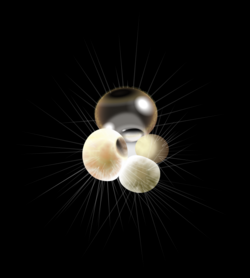Biology:Globigerina bulloides
| Globigerina bulloides | |
|---|---|

| |
| Rendering with spines | |
| Scientific classification | |
| Domain: | Eukaryota |
| Clade: | Diaphoretickes |
| Clade: | SAR |
| Phylum: | Retaria |
| Subphylum: | Foraminifera |
| Class: | Globothalamea |
| Order: | Globigerinida |
| Family: | Globigerinidae |
| Genus: | Globigerina |
| Species: | G. bulloides
|
| Binomial name | |
| Globigerina bulloides d'Orbigny, 1826
| |
Globigerina bulloides is a species of heterotrophic planktonic foraminifer with a wide distribution in the photic zone of the world's oceans. It is able to tolerate a range of sea surface temperatures, salinities and water densities, and is most abundant at high southern latitudes (up to 40° S), certain high northern latitudes (up to 80° N), and in low-latitude upwelling regions. The density or presence of G. bulloides may change as a function of phytoplankton bloom successions,[1] and they are known to be most abundant during winter and spring months.[2]
Like other planktonic foraminifera, G. bulloides carbonate tests found in marine sediments obtained from ocean cores can be used to reconstruct climatic histories, and to align marine sediment cores with one another or with astronomical cycles. In this vein, oxygen isotopic analyses of these forams from drill cores in the North Atlantic have helped precisely date the timing of the onset of northern hemisphere glaciations in the late Pliocene, 2.5–3 million years ago.[3] Magnesium to calcium ratios are also used in G. bulloides to reconstruct temperature histories in the world's oceans, as experimental cultures of the foram have shown magnesium to calcium ratios to increase exponentially with increasing ocean temperature.[4]
At one point in the 19th century, researchers of the life-histories of this genus came to the firm conclusion that these animals lived and died in the ooze in which they were found, many hundreds of feet below sea level.[5][6] This has now proved to have been an incorrect assumption,[when?] despite the thoroughness of those investigations.
References
- ↑ "National Geophysical Data Center". NOAA. http://www.ngdc.noaa.gov/mgg/geology/hh1996/bulloides.html.
- ↑ Deusser, W. G.; Ross, E. H.; Hemleben, C.; Spindler, M. (1981). "Seasonal changes in species composition, number, mass, size, and isotopic composition of planktonic foraminifera settling into the deep Sargasso Sea". Palaeogeography, Palaeoclimatology, Palaeoecology 33 (1–3): 103–127. doi:10.1016/0031-0182(81)90034-1. Bibcode: 1981PPP....33..103D.
- ↑ Bartioli, G.; Sarnthein, M.; Weinelt, M.; Erlenkeuser, H.; Garbe-Scheonberg, D.; Lea, D. W. (2005). "Final closure of Panama and the onset of northern hemisphere glaciation". Earth and Planetary Science Letters 237 (1–2): 33–44. doi:10.1016/j.epsl.2005.06.020. Bibcode: 2005E&PSL.237...33B.
- ↑ Lea, D. W.; Mashiotta, T. A.; Spero, H. J. (1999). "Controls on magnesium and strontium uptake in planktonic foraminifera determined by live culturing". Geochimica et Cosmochimica Acta 63 (16): 2369–2379. doi:10.1016/S0016-7037(99)00197-0. Bibcode: 1999GeCoA..63.2369L.
- ↑ George Charles Wallich (1876). Deep-sea Researches on the Biology of Globigerina. J. van Voorst. https://books.google.com/books?id=K4pNAQAAMAAJ&pg=PA60.
- ↑ Charles Wyville Thomson (1873). The Depths of the Sea: An Account of the General Results of the Dredging Cruises of H.M.SS. "Porcupine" and "Lightning" During the Summers of 1868, 1869, and 1870. London: Macmillan and Co.. pp. 21–22, 410. https://books.google.com/books?id=JgTLJ-h9BkkC&dq=bulloides&pg=PA21.
Wikidata ☰ Q5571055 entry
 |

